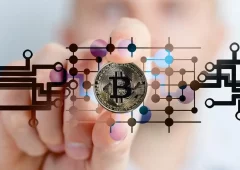Growing Interest in XRP Boosts Exchange Activity
06.08.2024 15:00 1 min. read Alexander Stefanov
Interest in XRP has surged on digital asset platforms following a favorable court ruling for Ripple Labs against the SEC, clarifying that XRP sold on exchanges is not a security.
Crypto analytics firm Kaiko reports that demand for XRP is making a strong comeback on digital asset exchanges.
Following a protracted legal battle with the U.S. Securities and Exchange Commission (SEC), which concluded with a ruling that XRP sold on exchanges does not qualify as a security, Kaiko notes that interest in XRP has resurged.
The demand for XRP in U.S. markets has been steadily increasing since the landmark court decision last year that granted Ripple Labs a partial victory against the SEC. Over the past year, the share of U.S. platforms in the global XRP trading volume has grown from less than 2% to 14%, reaching levels seen before the SEC lawsuit.
The inability of major exchanges to offer XRP trading during the lawsuit created a buildup of trader interest that has flourished post-ruling. The court’s summary judgment indicated that Ripple’s XRP sales via secondary trading platforms were not securities transactions, although direct sales to institutional investors were considered as such.
After the ruling, several U.S. exchanges, including Coinbase and Gemini, resumed listing XRP, releasing accumulated demand from U.S. traders. Ripple’s ongoing legal issues with the SEC continue to contribute to XRP’s volatility.
-
1
Cathie Wood Explains Why She Prefers Bitcoin Over Ethereum
28.09.2025 14:00 1 min. read -
2
Major Token Unlocks to Watch This Week: Over $190 Million in New Supply Incoming
05.10.2025 16:16 2 min. read -
3
VanEck Report: Institutional Crypto Holdings Hit $135B as Ethereum’s Fusaka Upgrade Nears
05.10.2025 12:30 2 min. read -
4
🔴Bitcoin Hyper Live Updates: Best Crypto Presale Tracker
14.10.2025 15:05 1 min. read -
5
Ex-BlackRock Strategist Says Ethereum Entering New Growth Phase as Institutional Inflows Surge
08.10.2025 10:00 2 min. read
Bitcoin and Ethereum ETFs Recover Momentum on Rate-Cut Speculation
A sudden market pivot has brought US Bitcoin and Ethereum ETFs back into favor after recent turbulence.
BNB Chain’s Joke Token “4” Turns Early Buyer’s $3K Into Millions
On October 1, 2025, BNB Chain’s official X account was briefly hacked, with attackers posting phishing links to millions of followers.
Best Crypto to Buy this October? Snorter Token Launching in 5 Days as Presale Hits $4.5M
Despite the recent crypto dip affecting Bitcoin and many major altcoins, there is some momentum building up behind meme coins. The TRUMP (TRUMP) token ETF filing is making progress, as Canary Capital’s Trump Coin ETF (TRPC) lists on the Depository Trust & Clearing Corporation (DTCC). This, alongside the Pudgy Penguins (PENGU) ETF filing in September, […]
[LIVE] XRP Price Prediction Today — Swell 2025 3-Week Countdown, Price Targets, Market Moves
Ripple’s Swell 2025 is three weeks away. It historically acts as a catalyst for short-term bullish setups in XRP price, positioning the next 21 days for a potential momentum build despite recent volatility. Scheduled for early November, the conference gathers top payments and finance leaders, including Nasdaq CEO Adena Friedman and digital asset heads from […]
-
1
Cathie Wood Explains Why She Prefers Bitcoin Over Ethereum
28.09.2025 14:00 1 min. read -
2
Major Token Unlocks to Watch This Week: Over $190 Million in New Supply Incoming
05.10.2025 16:16 2 min. read -
3
VanEck Report: Institutional Crypto Holdings Hit $135B as Ethereum’s Fusaka Upgrade Nears
05.10.2025 12:30 2 min. read -
4
🔴Bitcoin Hyper Live Updates: Best Crypto Presale Tracker
14.10.2025 15:05 1 min. read -
5
Ex-BlackRock Strategist Says Ethereum Entering New Growth Phase as Institutional Inflows Surge
08.10.2025 10:00 2 min. read
In a move that could reshape cross-border payments in Central America, Banco Industrial, Guatemala’s leading bank, has integrated blockchain-based infrastructure from SukuPay into its Zigi mobile app—offering instant U.S.-to-Guatemala remittances for under $1.
Kylian Mbappe's X account was recently hacked, and the attacker used it to promote an altcoin called MBAPPE.
Crypto exchange WazirX, which was recently hit by a $230 million cyberattack, has announced that it will allow partial withdrawals in Indian Rupees (INR) starting from August 26.
A bizarre cyberattack involving the hacked Instagram account of hip-hop group Migos has surfaced, allegedly as part of an attempted extortion scheme aimed at Solana co-founder Raj Gokal.
A hacker recently minted 120 million $YU tokens on the Polygon network and swiftly began unloading them across multiple blockchains.
A security flaw in Abracadabra’s smart contracts has led to a major exploit, with a hacker draining around 6,262 ETH—valued at roughly $13 million—from the protocol’s liquidity pools.
A recent investigation has revealed that $29 million worth of Sui (SUI) was stolen from a single victim in December.
A cyberattack on X (formerly Twitter) recently disrupted access for thousands of users, but the issue was quickly resolved.
The notorious hacking group known for its crypto thefts has lost access to nearly $5 million in stablecoins, following actions taken by stablecoin issuers to freeze the funds.
A wallet connected to the hacker who stole over $235 million from the Indian crypto exchange WazirX recently moved $6.5 million through the sanctioned crypto mixer Tornado Cash.
The U.S. government successfully reclaimed nearly $19.3 million in cryptocurrency within 24 hours after it was mysteriously drained from government-associated wallets.
A decentralized exchange targeted in a multi-million-dollar exploit has recovered its losses just days after the incident, thanks to an unexpected twist involving the hacker themselves.
The hacker responsible for the recent breach at the decentralized finance platform Radiant Capital has shifted nearly all stolen funds from layer-2 networks to Ethereum, likely to hide their trail.
Hackers have exploited a vulnerability in DeFi aggregator 1inch's resolver smart contract, leading to losses of over $5 million, according to blockchain security firm SlowMist.
In a concerning escalation of cyberattacks, hackers recently compromised the official Nasdaq X account to promote a fraudulent memecoin called STONKS.
The UFC's official Instagram was hijacked last night, with cybercriminals using the account to advertise a fraudulent memecoin.
A sophisticated cyberattack targeting Brazil’s central bank reserve accounts has resulted in the theft of over $140 million (R$800 million), much of which was swiftly funneled through cryptocurrency channels.
In a dramatic crypto heist, three hackers executed a scheme that defrauded a single victim of $243 million on August 19, 2024.
A recent cyberattack targeting a UK government official’s social media account has highlighted ongoing concerns over digital impersonation and crypto scams.
Crypto security incidents remain a persistent challenge, with September alone seeing $120 million in losses from various hacks.


